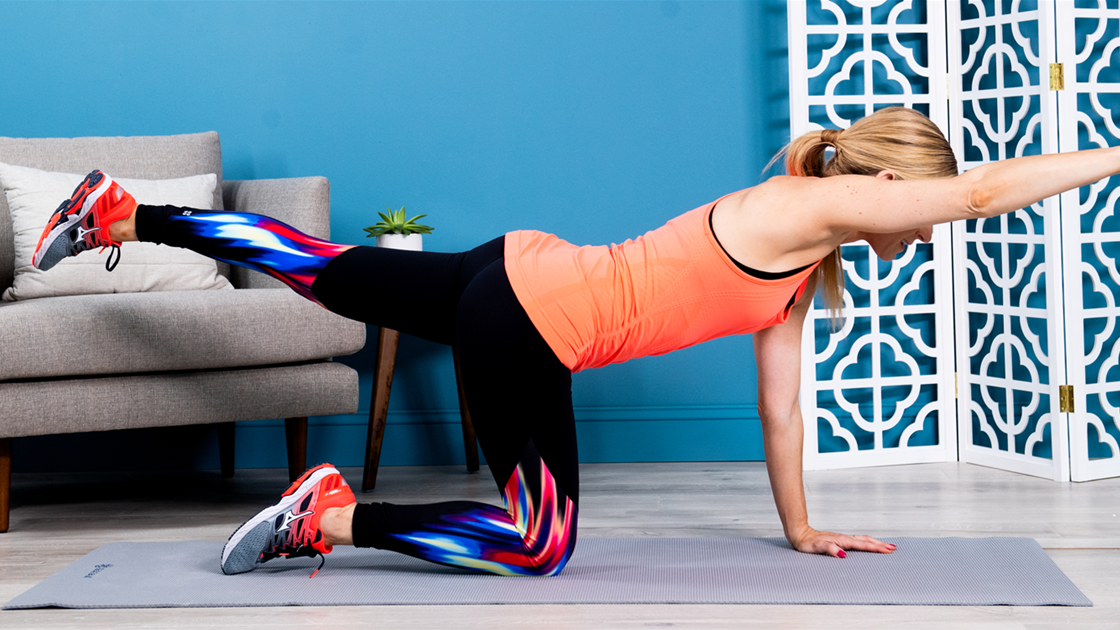We take our back for granted because we don't realise how much we use it every day. Whether you have an office job and are constantly hunched over your desk, or you're running around town carrying heavy groceries, the weight on your shoulders quickly adds up. That's why it's so important to exercise your back. It's home to one of the largest muscle groups in your body and has many important functions, such as keeping your core and shoulders stabilized. Your back is also the bridge between your upper and lower body.
"Your back is the powerhouse of your body, and it's what keeps you erect. It helps you maintain your posture and keeps your spine aligned. We also tend to do a lot of forward motions, such as texting and typing, which rounds our backs and makes them weak," explains Larysa DiDio, a certified personal trainer and creator of Tone Up in 15, a fitness DVD filled with 15-minute workouts that target a variety of muscle groups.
"Strengthening your back helps you decrease your risk of injury, makes you overall stronger, and helps make everyday activities easier," DiDio says. Good news for you: The back exercises below target every muscle in your posterior chain, including the traps (upper back), rhomboids (shoulder blades), deltoids (front and back upper-arm and shoulder muscles), and the latissimus dorsi (the mid- to lower-back). That said, DiDio recommends you do back exercises two to three times a week and work your back twice as much as your chest when doing a total-body workout. "So if you're doing two chest exercises one day, I suggests doing four back exercises too," she says.
When you're doing back exercises, maintaining form is key: "You need to make sure that your back isn't rounded and always flat. Keep your head in a neutral position and engage your core as much as your back," DiDio says.
Ready to put some back into it? Try the workout below to help you build a stronger upper body and prevent back pain.
Reps: 8 to 12 reps per exercise for 3-4 rounds
1. Swimmers
This back exercise looks deceptively easy, but if you're tightening your core and truly engaging your lats, deltoids, and traps, you'll feel a burn. The key here is to keep your chest and thighs lifted throughout the entire movement.
How to do swimmers: Lie face down on a yoga mat and extend your arms in front and legs behind you. Tightening your core and back, lift your right hand and left leg off the mat at the same time. Then, alternate sides by raising your left hand and lifting your right leg behind you. Move at a fast pace to get your heart rate up.
2. Bird dog
Although bird dog is mostly known as a core stabilizing exercise, your back muscles are recruited to help you balance and keep your hips square as you lift one hand and leg up.
How to do bird dogs: Get into tabletop position with your hands shoulder-distance apart, your shoulders directly over your wrists, and your hips in line with your knees. Engaging your core and back, bring your right elbow to your left knee, then raise your right hand in front of you and lift your left leg behind you. Focus on a spot in front of you to help you balance. Pause for a second before bringing your hand and knee back down to the mat. Alternate sides. This is one rep.
3. Supermans
Good mornings start with a solid hip hinge, while keeping your back straight as you fold forward. Depending on your range of motion, the goal is to lower your torso until it's parallel to the floor.
How to do good mornings: Stand with your feet hip-distance apart and your hands resting behind your head. Hinge forward from the hips, lowering your torso until it becomes parallel to the floor. Pause for a second before bringing your torso back up to stand. This is one rep.
5. Bent-over row
It's all about form when it comes to strength training for your back. In this particular exercise, you want to maintain a slight bend in the knees and hinge forward at the hips to help protect your low back. If you were checking your form in the mirror, your butt should be out and your back flat.
How to do a bent-over row: Stand with your feet shoulder-distance apart with a slight bend in the knees. Hold a dumbbell in each hand and hinge forward at the hips, allowing the weights to hang down. Keeping your back flat, row the left dumbbell up toward your rib cage and then bring it back down. Alternate sides and row the right dumbbell up toward the rib cage and lower it down. This is one rep.
6. Reverse flys
Targeting your lats and rear delts, this back exercise challenges your upper body strength to maintain form. Pro tip: Imagine that there's a pen between your shoulder blades. You don't want the pen to fall, so remember to keep the back flat and squeeze your shoulder blades together at the top of the movement.
How to do reverse flys: Stand with your feet shoulder-distance apart with a slight bend in the knees. Hold a dumbbell in each hand and hinge forward at the hips, allowing the weights to hang down. Maintaining a flat back, lift the weights out to the sides and squeeze your shoulder blades together. Lower the weights back down to the starting position. This is one rep.
7. Romanian deadlifts
Also known as a stiff-leg deadlift, this back exercise works your entire posterior chain, including your glutes. Unlike a conventional deadlift, your butt stays up the entire time. Remember to engage your core to keep your back flat and prevent arching.
How to do Romanian deadlifts: Stand with your feet hip-distance apart with a slight bend in your knees. Hold a dumbbell in each hand with your palms facing the front of your thighs. Hinge forward at the hips, keeping your back flat, as you lower the weights toward your feet. Squeezing your glutes, bring your body back up to stand.
8. High row
The high row is a great back exercise because it engages your front and back deltoids. Again, you want to maintain a flat back with this exercise to ensure you're targeting the right muscles.
How to do a high row: Stand with your feet shoulder-distance apart with a slight bend in the knees. Hold a dumbbell in each hand with your palms facing down, and hinge forward at the hips. Row the right dumbbell up to your right shoulder with your elbow pointing up and back. Bring the weight back down and row the left dumbbell up to your left shoulder. Lower the weight down to the starting position. This is one rep.
9. Upright row
This variation of an upright row has two different movements: a high pull and shoulder rotation. Together, they target different back muscles, including your deltoids and rhomboids.
How to do an upright row: Stand with your feet hip-distance apart and hold a dumbbell in each hand with your palms facing your thighs. Row the dumbbells together up to your shoulders, elbows pointing to the sides and up. Then, rotate your shoulders back to form cactus arms. Bring the weights to the high pull position before lowering them down to your thighs. This is one rep.
10. Push-up with renegade rows
Incorporating renegade rows into this push-up variation helps target the lats and rhomboids, as well as your shoulders, biceps, and core. To get the most out of this exercise, avoid rotating or moving your hips when you lift the weight off the mat. This will force you to engage your core more.
How to do a push-up with renegade rows: Start in a high plank position with your hands shoulder-distance apart, holding a dumbbell in each hand. Tightening your core and glutes, perform a push-up, lowering your body toward the mat. As you push off the floor to lift your body back up to plank, row the right dumbbell up toward your rib cage with your elbow pointing back. Lower the weight back down to the mat. Then, row the left dumbbell up toward your rib cage and bring it back down. This is one rep.








.png&h=193&w=250&c=1&s=1)

